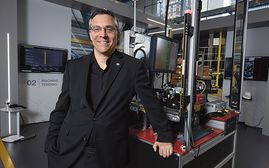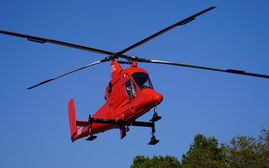Processing Your Payment
Please do not leave this page until complete. This can take a few moments.
- News
-
Editions
View Digital Editions
Biweekly Issues
- May 13, 2024
- April 29, 2024
- April 15, 2024
- April 1, 2024
- March 18, 2024
- March 4, 2024
- February 19, 2024
- February 5, 2024
- January 22, 2024
- + More
Special Editions
- Lists
- Viewpoints
- HBJ Events
- Business Calendar
- Custom Content
Walsh focuses on innovation as Kaman counteracts supply chain, inflationary pressures
 PHOTO | HBJ PHOTO FILE
Ian Walsh poses in front of a painting of Charles Kaman, the famed founder of Bloomfield manufacturer Kaman Corp.
PHOTO | HBJ PHOTO FILE
Ian Walsh poses in front of a painting of Charles Kaman, the famed founder of Bloomfield manufacturer Kaman Corp.
More Information
While we were all hoping to run victory laps in 2021 after the pandemic challenges of the previous year, COVID-19 and its new variants have proved a longer-term foe.
Anyone running a business in the last 20 months has had to lead during a time of great uncertainty.
That’s definitely the case for Ian Walsh, chairman, president and CEO of Bloomfield-based Kaman Corp.
He took over the top spot at the global aerospace, medical and industrial manufacturer in Sept. 2020, during a time of transition for the company.
Earlier that year Kaman completed its $317.5 million purchase of California-based Bal Seal Engineering Inc., a maker of precision seals and springs for the medical, aerospace and defense markets.
In 2019, Kaman sold off its distribution unit for $700 million.
Despite all those challenges and changes, Walsh characterizes his early tenure as CEO as a net positive.
“I think, in a nutshell, it’s been phenomenal for me both personally and professionally,” Walsh said during a late November interview.
Lift off
With a fresh leadership team in place, including newly-installed CFO James Coogan, Walsh said he has the pieces in place to move the company toward bigger and better things.
“I feel very strongly that we have the best team in place to bring Kaman to the next level,” he said.
In order to get to the next level Walsh said Kaman conducted a companywide employee survey in 2021 as part of an effort to engage with all stakeholders. Two key takeaways quickly became apparent — employees wanted more education and training and they valued diversity and inclusiveness.
In response, Walsh said he’s leading a renewed effort toward lean and Six Sigma training.
“We’ve put in place some very intensive training focused on operations. … It’s all about looking at eliminating waste,” he said.
Walsh said he hopes a focus on lean operations will help the company weather the uncertainty of inflation and supply chain issues.
Inflation has driven up Kaman’s costs, which have been partially passed on to customers and absorbed internally. The bigger issue has been lead times due to supply chain logjams.
“Those have been extended and that’s a challenge,” Walsh said. “As we see lead times edge up we have to order those things earlier.”
Labor costs have also been a major issue in 2021, Walsh said. As the labor market tightens, Kaman, like many other employers, has had to increase salaries to attract employees.
“We’ve increased those entry-level wages,” Walsh said. Because Kaman operates throughout the United States and internationally, the impact of wage increases varies. In areas where wage costs are already relatively high, “we have to watch that,” Walsh said.
Even still, Kaman’s earnings have turned the corner in 2021, thanks largely to stronger business in key sectors like medical and industrial. Kaman reported a $14.7 million profit during the third quarter of 2021, reversing a loss in the year-ago period. Its revenues totaled $179.8 million.
Since Walsh took over the 3,200-employee company in Sept. 2020, Kaman’s stock price has dipped a bit, trading around $38 in recent weeks, down from about $43 a year earlier.
Strong cadence
Walsh came to Kaman from the REV Group, a designer, manufacturer and distributor of specialty vehicles, where he served as chief operating officer.
But before entering private industry, he was a captain in the U.S. Marine Corps.
Walsh has leveraged his military background to help in the development of Kaman’s unmanned aerial vehicles (UAVs). Kaman has a history in the space, having built and sold to the U.S. military its K-MAX TITAN unmanned cargo helicopters, which were used 10 years ago in Afghanistan.
“It literally saved lives,” Walsh said.
While the K-MAX served its purpose on the battlefield, Walsh said that about nine months ago he sat down with Kaman engineers and challenged them to design a “purpose-built autonomous vehicle.” The K-MAX had been retrofitted to operate without a pilot, but Walsh said he felt strongly there were greater efficiencies to be found if Kaman built an unmanned aircraft from scratch.
“I pushed very hard and within four months they had come up with a 50-percent scale model,” Walsh said.
In September, the company unveiled its KARGO UAV, a medium-lift, cargo-hauling unmanned aircraft that fits in a standard shipping container and can be unloaded and operated by as few as two people.
It will also be able to operate in wartime conditions when GPS is unavailable.
“It’s a very exciting opportunity and we’re at the very early stages,” he said. “We are currently building the full-scale demonstrator to fly late next year.”
Kaman has partnered with Near Earth Autonomy on the software for the KARGO UAV.
Looking ahead to 2022, Walsh said he’s optimistic.
“We’ve got the strong cadence and battle rhythm,” Walsh said, adding that putting the right people in the right roles with the resources to get the job done is his priority.
“That’s the Holy Grail of great business leadership,” he said.
Ian Walsh
Chairman, President & CEO
Kaman Corp.
Education: Bachelor’s degree, Hamilton College; Master of Public Administration, Harvard University’s John F. Kennedy School of Government; MBA, Harvard Business School
Age: 55
This story is part of our 5 We Watched recap. Click here to see other profiles part of this series.
Related Content

2022 Giving Guide
This special edition informs and connects businesses with nonprofit organizations that are aligned with what they care about. Each nonprofit profile provides a crisp snapshot of the organization’s mission, goals, area of service, giving and volunteer opportunities and board leadership.
Learn more
Subscribe
Hartford Business Journal provides the top coverage of news, trends, data, politics and personalities of the area’s business community. Get the news and information you need from the award-winning writers at HBJ. Don’t miss out - subscribe today.
Subscribe
2024 Book of Lists
Delivering Vital Marketplace Content and Context to Senior Decision Makers Throughout Greater Hartford and the State ... All Year Long!
Read Here-
2022 Giving Guide
This special edition informs and connects businesses with nonprofit organizations that are aligned with what they care about. Each nonprofit profile provides a crisp snapshot of the organization’s mission, goals, area of service, giving and volunteer opportunities and board leadership.
-
Subscribe
Hartford Business Journal provides the top coverage of news, trends, data, politics and personalities of the area’s business community. Get the news and information you need from the award-winning writers at HBJ. Don’t miss out - subscribe today.
-
2024 Book of Lists
Delivering Vital Marketplace Content and Context to Senior Decision Makers Throughout Greater Hartford and the State ... All Year Long!
ABOUT
ADVERTISE
NEW ENGLAND BUSINESS MEDIA SITES
No articles left
Get access now
In order to use this feature, we need some information from you. You can also login or register for a free account.
By clicking submit you are agreeing to our cookie usage and Privacy Policy
Already have an account? Login
Already have an account? Login
Want to create an account? Register
Get access now
In order to use this feature, we need some information from you. You can also login or register for a free account.
By clicking submit you are agreeing to our cookie usage and Privacy Policy
Already have an account? Login
Already have an account? Login
Want to create an account? Register







0 Comments